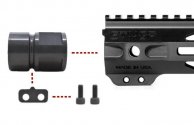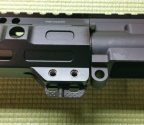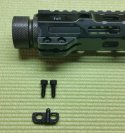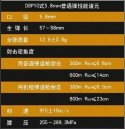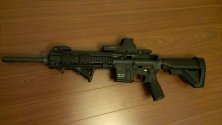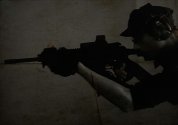Interestingly enough I believe the earliest military to adopt an AR15 with short stroke gas piston is in Taiwan. The T65 was in service by the mid 1970s and it had all of the ergonomics of the AR15 combined with AR18 gas system. Even the latest iteration of the rifle which is the T91 was designed in similar timeframe as the HK416. There are many who even believe the T91 is superior because it is lighter while still having less recoil than the HK416 (416s tend to be very overgassed for reliability which causes more recoil.) The point is that the HK416 really did not do much special and its design had been done a LONG time ago. However HK has an excellent marketing department and their build quality is excellent which popularized the Piston AR scene.
I sold my HK416 (civie version) before they got banned in Canada and I still miss it. Yes, the recoil was a bitch (and it's heavy.) But I'd rather deal with that than the inherent reliability problems of a DI system. I've had failures on DI ARs but I've never had a failure on any piston system (HK, SIG, AK) that was caused by the gun itself. My only failures on the 416 were due to the aftermarket magazine, which I stopped using, or the occasional dud primer. I actually stopped bothering to even clean my gun, because it was pointless. And we're not even talking about HK's barrel life, which is practically infinite.
The fact is that most militaries trust the piston-system for a good reason, despite the cost of higher recoil and weight.
The most important metric when it comes to firearms is reliability, much more than speed. Americans have a bias towards DI, but a lot of its own warfighters still admit that it can never be as reliable as pistons. You can't be pushing hot gases and fouling in the receiver and expect it to be as reliable as a piston. It's just physics.
With that said, I'll easily admit that any DI AR is a lot more fun to shoot than the 416, because DI feels like a laser by comparison. There's barely any recoil, which is especially important when you only weigh 160lbs like me. My 416 would literally be pushing me back on my heels even with good posture. And my forearms and shoulders would kill me after every range session because it's heavy. The learning curve on a piston system is much higher, but that also forces you to be a better shooter and focus on the fundamentals. I'd still pick piston systems over DI any day.
I guess that is why the competitors are 'slow', and because I am too used to the 'normal' style of competitive shooting lol.
IMHO, 1-man IPSC-type competions are pointless for infantry/SOFs, it's a waste of taxpayer bought ammo. They could have given them simunition or even paintballs and made them plan and execute a force-on-force operation against each other.











